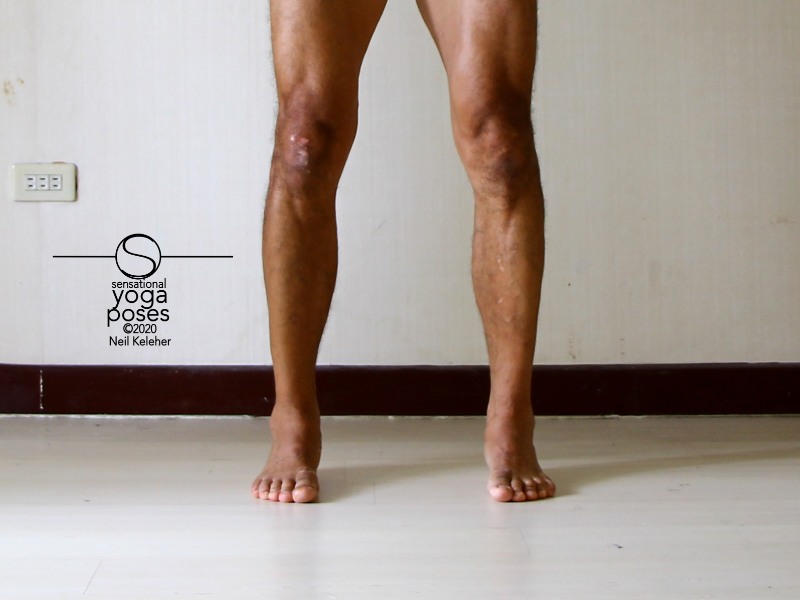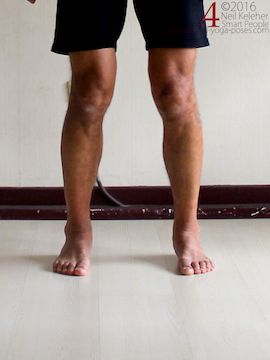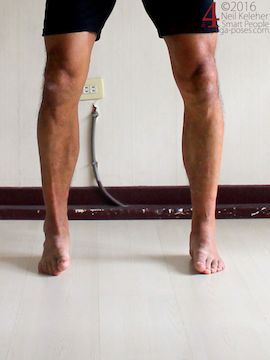Rolling Your Shins Out
The first part of these foot exercises involves rolling your shins outwards and then inwards. Do this while standing with feet parallel and knees slightly bent.
Doing this foot exercise with knees bent makes it easier to use the foot muscles to rotate the shins.
Doing it with knees straight, you may be using the long hip muscles to rotate your shins. (Not that there is anything wrong with that. It's actually another good exercise. However, it is a different exercise.)
Once you get used to feeling your feet activate, then try the same exercise with the knees straight.
The starting position is with the feet and ankles relaxed so that the shins naturally roll inwards.
The active part of this foot exercise is to use the feet to roll the shin outwards. Then to return to the starting position, relax the feet.
To increase foot awareness, and so that the exercise feels good, work at doing both actions slowly and smoothly.
When first doing the exercise you can try rolling your shins outwards as far as possible. As a result you may find that the inner edges of your forefeet lift.
As you get used to the "rolling out" action of this foot exercise, try rotating your shins to the point where they point straight ahead (in the same direction as your toes). Or another option, roll out to the point just before the inner edges of your forefeet lift.
Note that keeping your arches engaged all the time may be just as "bad" as having collapsed arches all of the time. One of the reasons for this foot exercise is to recognize the sensations that occur when your arches are engaged and to recognize the sensations when your foot is relaxed. Then you can choose whichever option you need.
On some occasions it may be helpful to allow your arches to collapse. Just as on other occasions it is helpful to have your arches engaged.
As a bonus foot exercise, try making your feet and ankles feel strong in the collapsed position.
As you do this foot exercise, you can notice the following:
- Notice how when you roll your shins out, the center of the inner arch of your foot lifts.
- You can also watch the tendons at the top of your foot. Notice how their fan pattern changes as you roll your shin.
- You can also look at the back of your heel and ankle. Notice how your Achilles tendon becomes straighter, more vertical, when your shins are rolled outwards.
When your shins are rolled out, you may be helping to stack the bones of your heel and ankle (the calcaneus and talus.) They can then support the weight of your body.
Since your shins rest on top of these two bones, this may also help provide a good foundation for your knees. You can then help keep your knees safe by activating your foot or feet any time your knees are in a potentially unsafe positions-perhaps while squatting or lunging or doing a yoga pose like warrior.
As another bonus foot exercise, try focusing on your heel when rolling your shins out. See if you can make your heel feel rigid or stiff.
You may find that your ankle feels stronger, more stable as a result.
Noticing the Effect of Shin Rolling Foot Exercises on the Pelvis
Rolling your shins out while doing this foot exercise, your pelvis may roll back slightly.
Rolling your shins in your pelvis may roll forwards.
Allow this to happen and focus on feeling your shins, feet and ankles while doing this action.
Noticing the Outer Edge of the Foot
I find that there is a natural tendency for the outer edge of my foot to press down as I roll my shins out. This may be a result of my inner arch lifting. As a result, I can use the minimum amount of effort to "press down" through the outer edge of my foot as I roll my shins out.
It is actually more like I am feeling my outer feet press down.
You can do the same thing. Rather than forcing the outer edge of your foot down, see if you can feel it as it moves closer to the floor. You might try shifting your weight forwards or back a little so that the base of your little toe presses down with just as much pressure as your heel.
Release this action as you allow your shins to roll back in.
An important note: The idea of pressing down through the outer edge of your foot isn't to lift your inner foot (This is called "Eversion.")
The idea is to press down through the outer edge of the foot without lifting your inner forefoot.
You may feel a slight "activation" just below the center of the back of your lower leg as you do so.
Three Additional Actions
This foot exercise involves other actions that you can add to on to the basic exercise one at a time. Each of these actions helps make flat feet unflat by training the muscles that help to support your foot in a non-flat footed configuration.
As you roll your shins outwards:
- Press your weight down through the outer edge of your forefoot. Keep the inner edge of the forefoot on the floor as you do this!.
- Pull up on the center of the arch of your outer foot.
- Press down through the base of your big toe.
As you press down through the base of your big toe, pull it back towards your heel. It will feel like you are gripping the floor with your feet!
Add these modifications on one at a time, getting comfortable with each action before adding on the next action.
Foot Exercise Details
Here are some details on the above modifications.
Pressing Your Outer Foot Down (aligning the heel)
The outer edge of your foot includes the bottom "heel bone" (calcaneus) as well as the bones that lead to the outer two toes. The inner part of the foot consists of the ankle bone (talus) and the bones leading to the inner three toes. The ankle bone sits on top of the heel bone.
Stacking the Heel and Ankle Bones
By rotating the shins outwards from the foot (as opposed to from the hip) we may be "stacking" the ankle bone over the heel bone.
To experience this, try balancing on your heels while rolling your shins out. Keep them rolled out and see if you can feel the bones of your heels being "stacked." Then roll your shins in and see if you can feel your heel collapse.
When rolling your shins out, see if you can feel when each ankle bone is "stacked" above the heel bones.
The image I like is that of someone-presumably a lady, pressing down through the heel of one of her 4 inch stilettos. However, instead of pressing down through a high heel, you are pressing down through your own heel.
Activating Your Outer Arch
The next step of this foot exercise involves lifting the center of the outer arch of your feet.
This part of the foot exercise isn't critical right at the beginning, and to tell the truth I skip this step alot of the time. However, as you become more and more foot aware, you may find that this step helps to create an anchor for a stable pelvis. It may also make for happier feet.
To lift through the outer arch of your foot you can simply pull up on the center of the outer edge of your foot, while pressing down through the base of your little toe and heel.
Practice activating and relaxing and when you activate you may notice a feeling of muscular contraction along the side of your shin.
That will be your Peroneus Longus activating. You may also be activating your peroneus brevis!
- The muscles that pull up on the outer arch are attached to the small bone of the lower leg (the fibula-so named because it lies a lot.) This bone doesn't bear weight but it does form part of the anchor for the biceps femoris.
- Stabilizing this bone by pulling up on the outer arches of your feet may help to anchor your hamstrings (of which the biceps femoris long head, which attaches to the Ischial Tuberosity) is one part.
- At the foot and ankle level, this muscle activation may also help in pulling the bones of the middle of the foot into their best position relative to teach other. This may help to support the center of the inner arch of the foot.
Pressing Down Through the Base of Your Big Toe
From an anatomical perspective, rooting through the inner edge of the forefoot (the "base" of the big toe) may help to stabilize the ankle bone (talus). This "activation" can also be important while running or walking. You can press through the this part of the foot to help propel your body forwards or even from side to side.
Note that if you have trouble rooting or pressing down through the root of your big toe you may be externally rotating your shin too much.
Try to slightly relax the external rotation, enough that you can easily press down through the root of your big toe. This action can be especially important when trying to stand or balance on one foot.
If you still have trouble pressing down through the root of your big toe, you can try to "suck" the front of your shin forwards without actually allowing the shin to move. This action can be used to activate tibialis anterior.
Doing these Foot Exercises with Minimum Effort
Ideally you won't have to do these foot exercises all of the time in order to maintain non-flat feet. Instead you simply learn to relax your foot or activate it at will. But prior to that an additional step comes into play once you've learned the elements of "Activating your foot." When you can activate your foot completely the next step is to practice using the minimum effort necessary to activate your foot.
What does minimum effort mean?
By activating your foot you are using the muscles of your foot, ankle and lower leg to position the bones of your foot, ankle and lower leg. Ideally the positioning is such that the bones in your lower leg support the weight of your body and any additional forces acting on it.
Anything more is wasted effort. Or it may adversely affect other parts of the body.
Part of the practice of this foot exercise is to notice if you are rotating your shins too far.
If you go too far you may limit the mobility of the hip joint, especially when you start doing this exercise with knees straight.
If you have trouble balancing on one foot with the knee straight as Half Moon pose it may be because you are rotating your shin outwards too much when activating your feet.
Using your Feet to Feel
Another reason for using minimal effort is that you may also want to use your feet to help you feel where you center of gravity is. For that the more relaxed your feet are, the easier it is to use them to sense where your weight is.
Actually, in general, the more relaxed you are given what you are trying to do, the easier it is to feel your body.
With your feet "ideally" activated, not only can you use your feet to support your body, you can use them to feel how your body relates to the earth.
Not Worrying by Focusing on Feeling What You Are Doing
It's a trial and error process. The best way to do trial and error (well one way to do it anyway) is to practice. And don't worry about when you get it wrong. Practice activating your feet and relaxing them, and see how little effort you can apply in order to shape your feet "ideally."
And so that it is easier to not worry about doing things wrong, focus on doing the exercise slowly and smoothly so that you can focus on feeling your feet while you exercise them.
Exercising your feet, learning to feel them and control them, you can then use them to support you in whatever you are trying to do, whether it is a yoga pose, tai ji, or just standing around enjoying a latte, the scenery or conversation with friends.
Published: 2020 08 05






